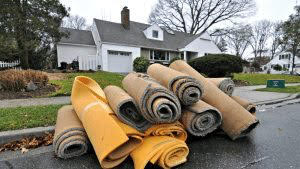
Submitted questions will be posted with my response by the following Tuesday or before.
Submitted comments will be moderated and approved within 24 hours.
New Program Verifies “Glyphosate-Free”
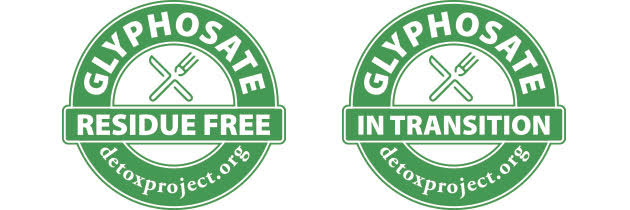
The Detox Project, who has been offering tests for humans to detex the presence of glyphosate pesticide in their bodies, is now moving into testing food for glyphosate residues and allowing the produce that passes to display the Detox Project glyphosate seal.
Last year they tested many popular processed foods for glyphosate residues and found m and published aa list of food products that do contain the pesticide in Glyphosate: Unsafe on Any Plate.
Now they are working on identifying the foods and food products that don’t contain residues of glyphosate.
They are currently inviting food producers to register for the process, so don’t rush to your local store and look for the seal.
There are two levels of verification.
Glyphosate Residue Free — “To be certified Glyphosate Residue Free, your product must have no glyphosate or AMPA residues down to the limits of laboratory detection (between 0.1 ppb and 20 ppb depending on the product), a standard that is tougher or the same as the U.S. Environmental Protection Agency’s Maximum Residue Limits (MRL).”
Glyphosate in Transition — “Glyphosate In Transition products have to show a low detection level (under 200 ppb of glyphosate and AMPA) in the first third party testing and then have to reduce this level to ‘Glyphosate Residue Free’ within a 2-year period.”
The transition seal tells consumers that a company is working toward eliminating glyphosate, which is good to know, but not good to eat. To me, “glyphosate in transition” means the food has been tested and it’s known to contain glyphosate.
It will be interesting to follow this and see if organic foods tested turn out to be glyphosate-free (as we assume they are) and who gets the transition rating.
LET’S DO SOMETHING ABOUT TOXIC AUTO INTERIORS!

I received the following email this week from a woman who wants to take some action to get toxics our of automobile interiors. I’m all for a collective effort on this and would like us all to work together on this. Please post in comments your support for this and any experiences you’ve had with toxic auto interiors, difficulties finding nontoxic cars, and anything else related. Thanks!
Interestingly, as I was looking for an image for this post, I found the image above on an article about stricter regulations on auto interiors in China! The article was published in The Hog Ring a place for auto upholstery professionals to read news, connect and talk shop” Maybe this is a place to start a discussion on this topic.
Question from Maria
Hi Debra,
I sued a Dealership and Mfg. for a brand new car that I bought that made me very ill.
I also filed as the first case with the government. they actually sent an independent inspector out who confirmed the toxins within the car.
I’ve been involved in these issues for approx. 30 years. I am looking for speakers, people that have experienced symptoms, etc. from new cars, any legislation. I would like to submit a proposal to our state to write laws, label cars as we do foods, investigate., witnesses , etc.
Any info., assistance, etc. would be appreciated.
Years ago EPA told me I was 7 years ahead of them in investigating the auto interiors and I was shocked to find out 20 years later that it still was not done.
I am willing to get this moving but need to get enough people to show there is a problem.
Thank you!
Unscented Bath Tissue
 This is the unscented bath tissue I use.
This is the unscented bath tissue I use.
Question from Kristal
Hi Debra,
I, along with many others, are having a terrible time finding bath tissue (toilet paper) that we can use. Charmin Basic worked well for all of us, but it has now been discontinued, and none of us have been able to find another tissue we can use without allergic reactions. Trying to find out what ingredients are causing this reaction is impossible, because they will not disclose ingredients contained in these products.
If you have any information, please share it…and in the meantime, I am planning on starting a petition to require ingredients to be disclosed on labels of all products that come in contact with the skin of consumers.
We also can’t find ingredients used in laundry detergents unless manufacturers choose to put them on their labels. I guess it’s not required. Any suggestions?
I subscribed to your page, but have not received a confirmation in my email yet so I can respond.
I have created a petition for Charmin to bring back Charmin Basic, so if you know anyone who might want to sign it and pass it on to others, that would be great. I did, at one time, manage to get a list of its ingredients, and I believe it contained Virgin Wood Pulp and a small amount of some kind of adhesive or glue to hold it together. Very few ingredients…three or less, is what I think they told me. I found 32 people who posted on Charmin’s facebook page who could not or would not use the replacements for various reasons, including many who had allergic reactions, and they could not find anything else on the market that was working for them. Just like me. Here’s a link to the petition:
www.ipetitions.com/petition/bring-back-charmin-basic
I am going to need to find people willing to sign a petition to submit to my legislators in Washington regarding requiring disclosure of ingredients on labels of all products that come in contact with skin, so I’m hoping to have my ducks in a row before I create the petition. I’d like to know I will have some support behind it. My thinking is that if they won’t tell you what is in these products, there is a good reason they are hiding that information.
Debra’s Answer
Good for you to do something about ingredients. I’m totally in agreement with you and will help however I can.
Did you see my recent post about Californians overwhelmingly in support of right-to-know legislation for cleaning product ingredients ?
We DO have a right to know all the ingredients in all products on the market. And we need to assert that right.
Food Safe Glass

Question from Chris
Hi Debra,
While looking at a large glass jar at Oriental Trading Wedding I noticed it was labeled “not food safe” use only wrapped candy. I was under the impression that all glass was food safe. I was reading your blog and am very curious niw about glass quality. Many of us store our foods in these jars.
Thanks.
Debra’s Answer
No, not all glass is food safe. There are many types of glass used for many purposes, each with it’s own characteristics.
The most common method of making glass is to heat raw materials into a molten liquid and then rapidly cool the liquid in such a way that the atoms remain in a random state.
The raw materials are various powders which include network formers, fluxing agents, property modifiers, fining agents, and colorants.
The two most common types of glass used in consumer kitchenware are soda-lime silicate glass and borosilicate glass.
Food safe glass is regulated by the federal Food & Drug Administration (FDA). Glass (and plastic) containers containers are consider “indirect food additives” by the FDA. These are substances that may come into contact with (and end up in) food from packaging or processing equipment, but are not intended to be added directly to food.
The FDA has determined that both borosilicate glass and soda-lime silicate glass are Generally Regarded as Safe (GRAS). The GRAS designation is given to substances added to food directly or indirectly that are considered to be safe by experts.
Here is a whole study about food-grade glass, prepared by The Glass Packaging Institute: Compliance of Glass Packaging with Human and Environmental Health and Safety Toxic—in—Packaging Requirements.
This document states:
Preference for glass has persisted throughout the ages and in all cultures due in large part to its safety, impermeability, and durability. In food packaging applications, glass has long been recognized as the gold standard, due in significant part to its being virtually inert, meaning that it does not react with other elements and forms no new compounds when it comes into contact with other chemical agents or compounds. As a result of this virtually inert quality, glass does not interact with the foods or beverages contained in it, and consequently does not affect the flavor of its contents. Similarly, glass is virtually impermeable to oxygen, so does not affect — and is indeed protective of — the freshness of its contents. Consequently, glass does not require the addition of any food additives or preservatives in order to maintain flavor or freshness, unlike many other food packaging materials. Glass has long been recognized as the preferred material for food packaging, due to this virtually inert quality and its protection of the food or beverage that it contains.
It also states:
Unlike other packaging materials, glass packaging is manufactured at extremely high heat with simple components, resulting in oxidation of most trace amounts of heavy metals that may be present in the raw production materials [italics mine]. For this reason, and because glass packaging is virtually inert, glass packaging properly does not present any significant health and safety or environmental concerns.
Therefore even if there were any heavy metal impurities in the raw materials, they would not be present in the finished glass product.
I haven’t read the entire 50-page document so there may be more relevant information. But these are the key items for this discussion.
Soda-lime-silicate glass is made from three ingredient—sand, lime and soda ash. No lead or other heavy metals are added to this glass for any reason. Borosilicate glass is made of by adding boric oxide to the basic soda-lime-silica mix.
Lead is added to glass to make it sparkle in the light. But this is very clearly labeled with lead warnings. This is limited to “cut crystal.” And the lead WILL leach into foods and beverages. Other types of decorative glassware may also contain lead and not be so labeled because it is not intended for contact with food.
For food storage, only use glass containers intended to be used as food containers. Those will be made with a food-safe glass.
Decorative glass items are usually NOT food safe and probably contain unknown substances that can leach into food.
Can I Keep My Old Carpet?
Question from Lynnette
Hi Debra,
I so appreciate what you do and your website. It has been a life saver with my MCS.
I have 25 year old carpeting. It was one of the triggers to getting MCS and other health issues but it took 10 years after installing to find out about MCS.
My question now is I still have the carpets in my house. I heard that they have off-gassed and safe after six years. That is why I didn’t get rid of them. But now I am wondering if they are exposing us to chemicals in the carpets that might break down and go into the air and we breath them. If they are safe after all these years I don’t want to replace them at this time but if bad I am ready to pull them up and replace with a safer flooring.
Are old carpets o.k. or not?
Thanks so much.
Debra’s Answer
In my experience as a consultant, who has been to the homes of many clients with MCS, I just got to a point where if someone had carpet of any age I said, “Take out the carpet!”
Often it’s the last thing to go, but people didn’t start recovering until after they finally took out the carpet.
I remember telling this to one woman and she said, “OK let’s do it right now!” And we both got on our hands and knees and starting pulling out the wall-to-wall carpet. When we finally had it out of the house she said, “Wow! I didn’t know this would make such a difference. I can breathe!”
It would be interesting for you to do the HomeLab.com air quality monitoring and see how your carpet registers on the air quality monitor. That would give you real data about what you need to do.
The problems with air quality from carpet goes way beyond toxic exposures from synthetic fibers and finishes. I once took up a carpet and there was a whole nest of carpenter ants eating a hole in the floor under the carpet. And there’s padding and dust and mold and padding…
If you’re ready, my advice would be to just remove it and get a good nontoxic floor that you can clean.
Need Unscented Spray for Air Conditioner Coils
Question from Audrey
Hi Debra,
I live in South Florida so as you know I use the air conditioning a lot.
I have a company that services it and they are coming for the yearly check up in early May. They use deodorizer to spray the coils which as a MCS person I don’t allow.
Would it be okay to have the ac coils sprayed with a mixture of 1/2 vinegar and 1/2 water?
If not, do you have any suggestions what can be used? Thanks.
Debra’s Answer
I actually got a new air conditioner a couple of years ago so I haven’t had it checked for a while.
I don’t know it there is some reason why you shouldn’t use vinegar in an air conditioner.
Readers, any experience with this?
Safest Over-the-Counter Antihistamine?
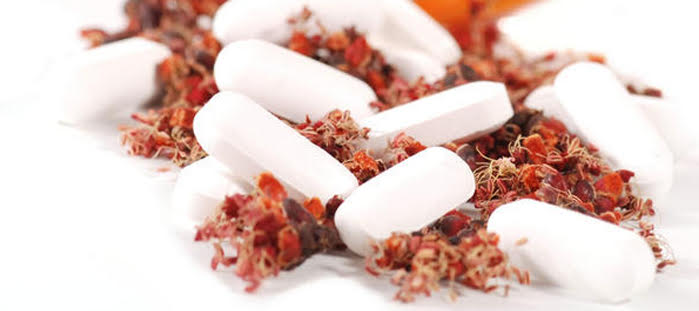
Question from Betty
Hi Debra,
I am curious to know what you think is the safest over-the-counter antihistamine to take. I’m sure it is best to avoid taking anything, but if someone has to, which do you think has the fewest additives, dyes, preservatives, etc.?
Thank you!
Debra’s Answer
I can’t remember the last time I took an antihistamine. Forty years I think.
I don’t think one OTC antihistamine is better than another. As far as I know there are no “natural” pharmaceuticals in the same sense that we have “natural” foods without artificial colors and flavors and presenvatives.
There are pharmaceuticals and there are natural alternatives.
My best suggestion is to search online for “natural antihistamines” or choose an alternative healthcare provider to help you with this issue. Herbs, homeopathy and other alternative practices can help get to the root cause of the problem you are seeking an antihistamine for.
Even some foods have an antihistamine effect.
You’ll find lots of natural solutions online.
Turmeric is often mentioned as an antihistamine, also vitamin C.
Readers, what do you use for antihistamine?
Asbestos Awareness
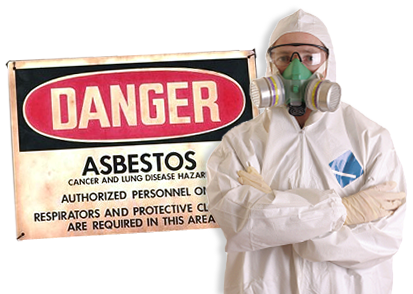
A reader alerted me to the fact that this week is Asbestos Awareness Week.
I haven’t written much about asbestos because I thought it was banned. In fact, on 12 July 1989, the EPA issued a final regulation banning most uses of asbestos, but not all. But the asbestos industry filed a lawsuit against the EPA and overturned the ban. Read more about the ban and current restrictions
Then Mesothelioma + Asbestos Awareness Center wants to see a future where a highly preventable cancer is virtually non-existent because people are more aware as to where the hazardous material can be found in their homes and occupations. They also provide information for those who are interested in learning more about the cancer as they themselves are experiencing it, or are students learning about other lung diseases as they enter health and medical fields.
While asbestos is not as widely used today as it was in the past, it is still found in some consumer products. Shannon also sent me an article about five products that still contain asbestos: car parts, insulation, construction materials, fireproof clothing, and potting soils. Potting soils? It’s the vermiculite in potting soils that may be contaminated with asbestos, as they occur in nature together.
Other domestic products that may contain asbestos include:
- Crock pot linings and around the power cord: especially those manufactured prior to 1980
- Ironing board covers either made with asbestos cloth or had asbestos fibers weaved into the material: those commonly sold around the 1960
- Hair dryer heating elements: those produced prior to 1979, though there is a possibility of foreign-made hair dryers still containing some amount of asbestos
And if you are looking for or living in an older home to avoid outgassing of VOCs from modern building materials, those older homes are the most likely to contain asbestos. Within those homes asbestos can be found in roofing tiles, vinyl flooring (installed prior to 1980), popcorn ceiling, piping, and wall boards.
Here’s another post on this blog about asbestos: Q&A: My Personal Experience with “Second -Hand” Asbestos.
Is There a Safe Wallpaper?
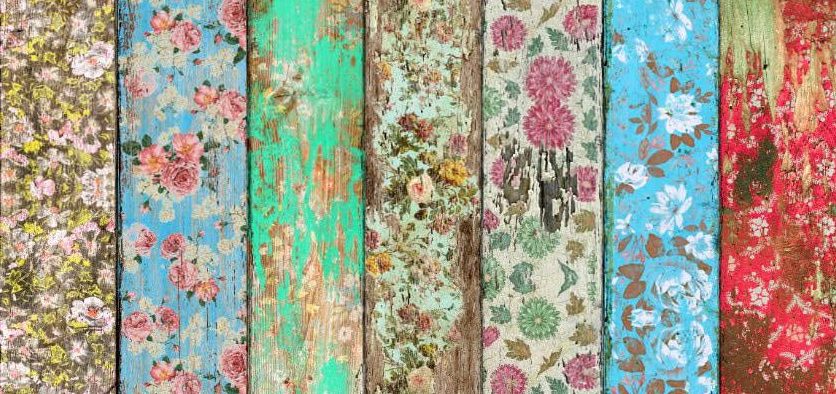
Question from Eliana
Hi Debra,
I am thinking of having wallpaper in my dining room. The selection of non-vinyl wallpaper is very slim. I am very green and keep indoor air as clean as I can. The question is, does vinyl off gas forever? The other question is, what about the glue they use to put it up. Is it sealed once the wallpaper is on and if not does it off gas forever?
It is so challenging to stay green in the world we live in.
Please let me know?
Thanks so much.
Debra’s Answer
Soft vinyl outgassed forever, to a lesser and lesser degree as time goes by. I really recommend no using vinyl wallpaper.
In addition, if you use air conditioning, mold can grow behind wallpaper which is a vapor barrier stopping hot and moist exterior air entering walls in summer.
Over the years I’ve seen a few uncoated paper wallpapers, but personally, if you want a pattern on the walls, I would stencil or hand paint the pattern with a nontoxic paint rather than try to deal with a paper wallpaper. I’m concerned it may mold.
Here is a very good list of the many different types of wallpapers, showing the materials—both synthetic and natural—used to make them:
Wallpaper Types, Textures, And Their Different Applications
And here is a resource about wallpaper adhesives:
Wallpaper Adhesives
The choices for paste seems to be vinyl, wheat, or cellulose.
So it IS possible to find a natural wallpaper and a natural paste, but I am concerned about mold, especially in a humid environment.
Chlordane Alert
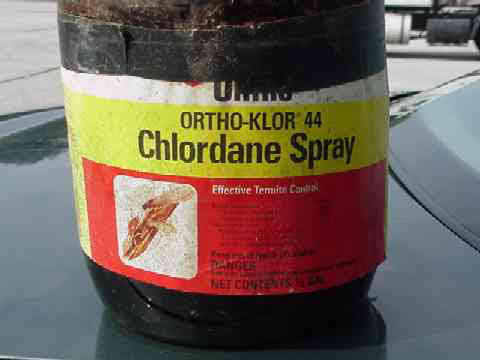
Question from Magda
Dear Debra,
Originally I thought that chlordane would not be a problem in and around houses any more. Until I came upon the study, article, and description of practices excerpted below.
Sorry to bring up such a long, unpleasant litany, now that spring is here and the daffodils are blooming!
But I live in Iowa and love gardening. It is very hard not to weed close to house walls, where a potential contmination would be worst, and has possibly been spread around through the building of porches, digging near foundations etc.
Do you know of any chlordane test except the one offered by Dr. Richard A. Cassidy of Toxfree, who also put the mentioned practices described below on the internet?
Thank you very much in advance. Thank you also for helping us ordinary people (who do not know science) live healthier lives.
Magda
STUDY
Health Dangers of Chlordane
by Dr. Edward Group DC, NP, DACBN, DCBCN, DABFM
[schema] published + updated Published on March 14, 2013, Last Updated on May 28, 2013
The University of Iowa examined soil samples and discovered that Cedar Rapids Iowa had chlordane soil contamination almost as severe as urban areas of China.
References
References:
Hedley AJ, Hui LL, Kypke K, Malisch R, van Leeuwen FX, Moy G, Wong TW, Nelson EA. Residues of persistent organic pollutants (POPs) in human milk in Hong Kong. Chemosphere. 2010 Apr;79(3):259-65. doi: 10.1016/j.chemosphere.2010.01.047. Epub 2010 Mar 2.
Bao LJ, Maruya KA, Snyder SA, Zeng EY. China’s water pollution by persistent organic pollutants. Environ Pollut. 2012 Apr;163:100-8. doi: 10.1016/j.envpol.2011.12.022. Epub 2012 Jan 11. Review.
Martinez A, Erdman NR, Rodenburg ZL, Eastling PM, Hornbuckle KC. Spatial distribution of chlordanes and PCB congeners in soil in Cedar Rapids, Iowa, USA. Environ Pollut. 2012 Feb;161:222-8. doi: 10.1016/j.envpol.2011.10.028. Epub 2011 Nov 26.
Mast MA, Alvarez DA, Zaugg SD. Deposition and accumulation of airborne organic contaminants in Yosemite National Park, California. Environ Toxicol Chem. 2012 Mar;31(3):524-33. doi: 10.1002/etc.1727. Epub 2012 Feb 6.
Morrissey CA, Pollet IL, Ormerod SJ, Elliott JE. American dippers indicate contaminant biotransport by Pacific salmon. Environ Sci Technol. 2012 Jan 17;46(2):1153-62. doi: 10.1021/es2028058. Epub 2011 Dec 23.
Lopez J, Boyd D, Ylitalo GM, Littnan C, Pearce R. Persistent organic pollutants in the endangered Hawaiian monk seal (Monachus schauinslandi) from the main Hawaiian Islands. Mar Pollut Bull. 2012 Nov;64(11):2588-98. doi: 10.1016/j.marpolbul.2012.07.012. Epub 2012 Aug 9.
Everett CJ, Matheson EM. Biomarkers of pesticide exposure and diabetes in the 1999-2004 national health and nutrition examination survey. Environ Int. 2010 May;36(4):398-401. doi: 10.1016/j.envint.2010.02.010. Epub 2010 Mar 17.
Goldner WS, Sandler DP, Yu F, Hoppin JA, Kamel F, Levan TD. Pesticide use and thyroid disease among women in the Agricultural Health Study. Am J Epidemiol. 2010 Feb 15;171(4):455-64. doi: 10.1093/aje/kwp404. Epub 2010 Jan 8.
Vogt R, Bennett D, Cassady D, Frost J, Ritz B, Hertz-Picciotto I. Cancer and non-cancer health effects from food contaminant exposures for children and adults in California: a risk assessment. Environ Health. 2012 Nov 9;11:83. doi: 10.1186/1476-069X-11-83.
Sakamoto K, Nishizawa H, Manabe N. Behavior of pesticides in coffee beans during the roasting process. Shokuhin Eiseigaku Zasshi. 2012;53(5):233-6.
ARTICLE
Environ Pollut. 2012 Feb;161:222-8. doi: 10.1016/j.envpol.2011.10.028. Epub 2011 Nov 26.
Spatial distribution of chlordanes and PCB congeners in soil in Cedar Rapids, Iowa, USA.
Martinez A1, Erdman NR, Rodenburg ZL, Eastling PM, Hornbuckle KC.
Author information
Department of Civil & Environmental Engineering, IIHR-Hydroscience and Engineering, The University of Iowa, 4105 SC, Iowa City, IA 52242, USA.
Residential soils from Cedar Rapids, Iowa, USA were collected and analyzed for chlordanes and polychlorinated biphenyls (PCBs). This study is one of the very few urban soil investigations in the USA. The chlordanes concentrations ranged from 0 to 7500 ng g(-1) dry weight (d.w.), with a mean and standard deviation of 130 ± 920 ng g(-1) d.w., which is about 1000 times larger than background levels. ΣPCB concentrations ranged from 3 to 1200 ng g(-1) d.w., with a mean and standard deviation of 56 ± 160 ng g(-1) d.w. and are about 10 times higher than world-wide background levels. Both groups exhibit considerable variability in chemical patterns and site-to-site concentrations. Although no measurements of dioxins were carried out, the potential toxicity due to the 12 dioxin-like PCBs found in the soil is in the same order of magnitude of the provisional threshold recommended by USEPA to perform soil remediation.
Copyright © 2011 Elsevier Ltd. All rights reserved.
PRACTICES
Information provided by
Richard W. Pressinger (M.Ed.), Wayne Sinclair, M.D.
How to Correct Chlordane Home Contamination
Application to Outside Wood Surfaces
Chlordane was frequently applied to the outside wood surfaces of many homes built before 1988. This would have been done because of an actual termite problem or as a preventive safeguard from a worried homeowner. Under first consideration, the application to the outside of the home would not appear as a problem, however, as described in research on the chlordane web site, conducted by Dr. Kaye Kilburn of the the University of California, even outdoor applications of the chemical can find their way indoors to contaminate the interior to a level that can cause a variety of health problems from increased infections to increases in many neurological disorders including – anger, migraine headaches and depression.
Correction Procedure
The least expensive way to correct contamination of the exterior wood surfaces of a home is to seal the wood with a hard, enamel based paint. The most efficient method for correcting this problem is to identify which side of the home the problem exists and to then replace the contaminated wood pieces. If the home is constructed of 4×8 sheets of plywood siding, these sheets can be easily replaced for a materials cost of about $25.00 per sheet. Check with the pest control company who applied the chlordane and ask if their records show where chlordane was applied.
Infiltration up through the Foundation of the Home
This is the same route that radon has been found to contaminate homes throughout the U.S. When a home was built before 1988, standard procedure was to literally saturate 100 gallons of chlordane into the soil per 1000 square feet of home area just before the concrete foundation was poured. Therefore, a 2000 square foot home would have 200 gallons of chlordane saturated into the soil. After several years of “settling,” cracks form in the foundation and basement walls or around plumbing pipes which has been found to allow for entry of the chemical into the home.
Correction Procedure
Success has been shown with underground infiltration problems by simply identifying where the cracks in the foundation are located and sealing these with an acrylic caulking or similar compound. It is also recommended to caulk around all plumbing pipe entry points through the foundation. As chlordane was often concentrated in the outer one or two foot perimeter just underneath the foundation, there needs to be a good caulking seal at the point where the wall meets the floor
Attic Contamination
As the attic of a home is comprised of wooden 2×4 support beams, these were often sprayed with chlordane by a pesticide company to ward off future termite problems. Unfortunately, when the applicator is spraying the beams, the chemical can easily drip onto the ceiling drywall sheets that were nailed to the 2×4’s. Drywall is made of rock powders that act like a sponge, quickly absorbing the chemical and then outgas the chlordane into the living area below. Contamination would then occur to the area below which could be either the kitchen, living room or bedroom.
Correction Procedure
Ceiling drywall that has soaked up chlordane due to an attic application of chlordane can be widespread. Ceiling drywall can be purchased inexpensively in 3/8 inch thicknesses for around $5.00 for a 4×8 foot sheet. It is recommended that these be placed over existing ceiling drywall or to completely remove the existing drywall and to then apply new drywall.
Accidental Spills
The research has documented spills of chlordane containers occurring during testing research and has certainly happened to an unknown percentage of homes built before 1988. The spills could range from a few ounces to one gallon or 55 gallon containers. If one room registers a much higher chlordane level than another room – the possibility of a chlordane spill should be considered.
Correction Procedure
If a significant amount of chlordane has been spilled onto any inside flooring the two correction procedures in order of effectiveness include – painting the floor with an enamel based paint or laying ceramic or hard vinyl tile over the contaminated area.
Normal Application Residue
Although chlordane was routinely used outside the home up through March of 1988, it was often used for the indoor control of roaches and ants up until 1981. Chlordane was easily purchased by homeowners from department stores before this date as an effective roach and ant pesticide. Indoor areas routinely treated with chlordane include underneath the kitchen sink, behind the refrigerator, behind the dishwasher and along baseboards throughout the bedrooms. Sometimes the chemical odor of chlordane underneath a kitchen sink is “overwhelming” due to this area receiving repeated chlordane applications. Chlordane contamination still occurs today as many “garden/tool sheds” still have bottles of outdated chlordane on the shelves.
Correction Procedure
If contamination under the kitchen sink is suspected, perform a chlordane air test underneath the sink. High levels found here can be “sealed in” using new plywood or if air chlordane contamination is exceptionally high, the homeowner may be better off replacing the old counter top with a new one. Baseboards along the floor can be sealed with an enamel paint or can be replaced at a cost of 30 cents to $1.00 per foot.
Debra’s Answer
Thank you for all this information Magda. Chlordane is a very toxic pesticide and it’s important to know it’s still a hazard to watch out for.

